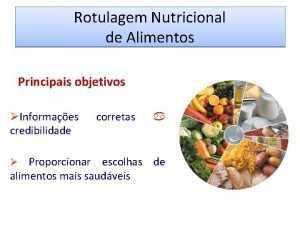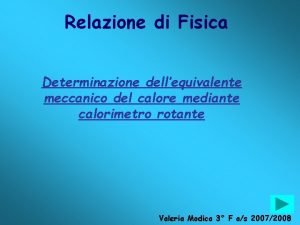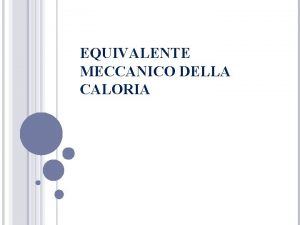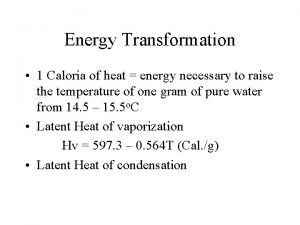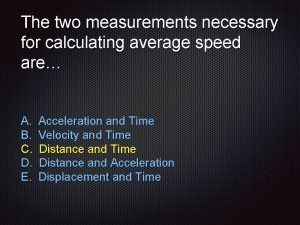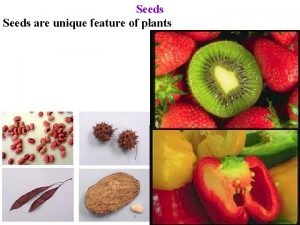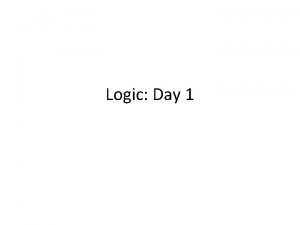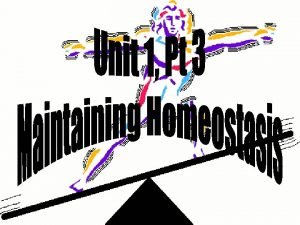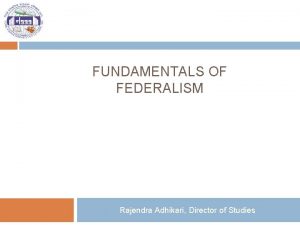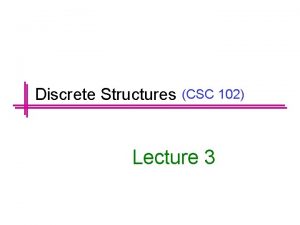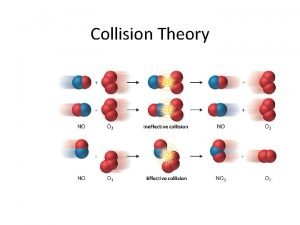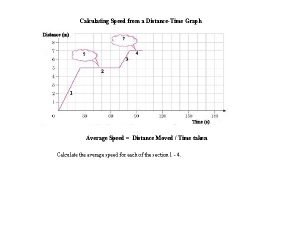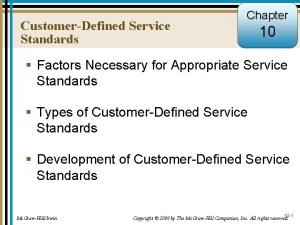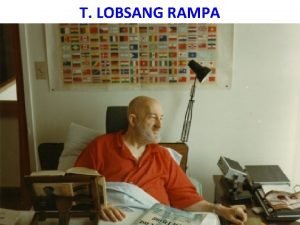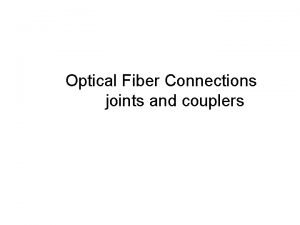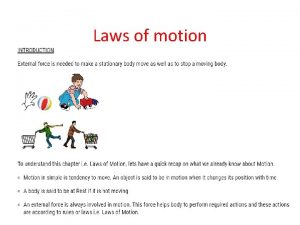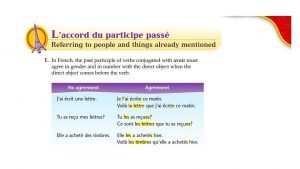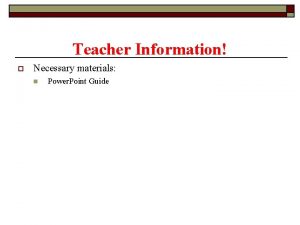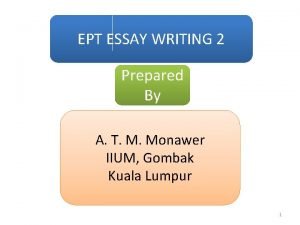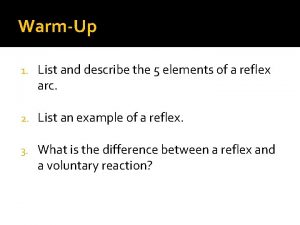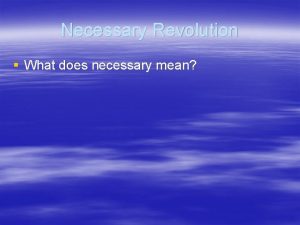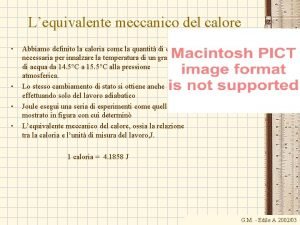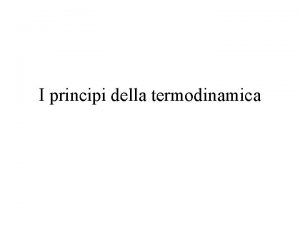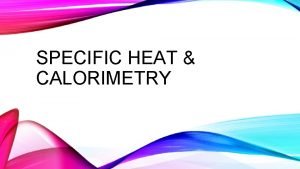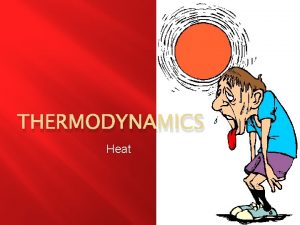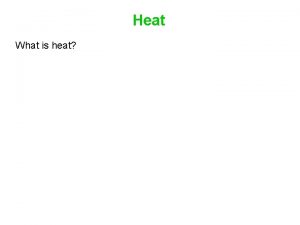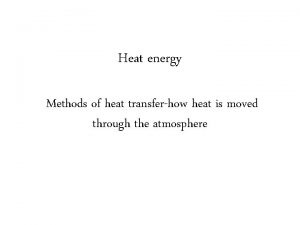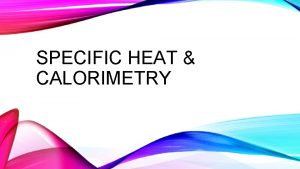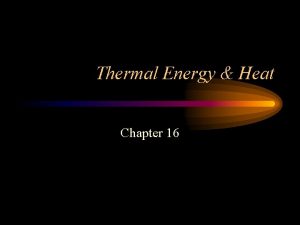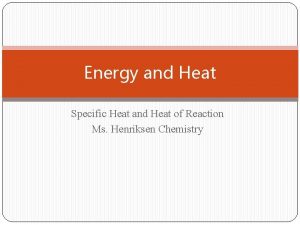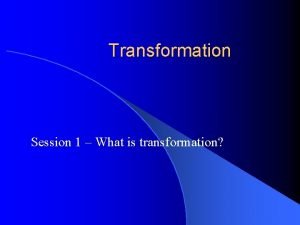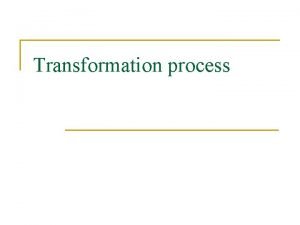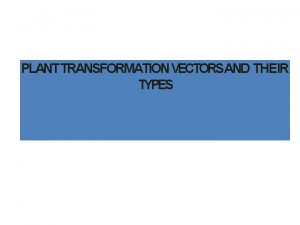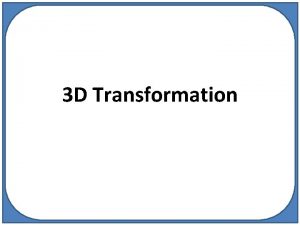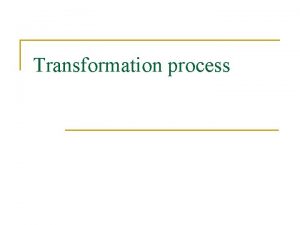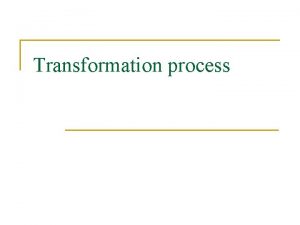Energy Transformation 1 Caloria of heat energy necessary






























![Permeameters • • Constant-head permeameter Qt = -[KAt(ha-hb)]/L. K = VL/Ath. V = volume Permeameters • • Constant-head permeameter Qt = -[KAt(ha-hb)]/L. K = VL/Ath. V = volume](https://slidetodoc.com/presentation_image_h/d25fe85aac2b7850fa67b92f8e13e1f6/image-31.jpg)

![Falling head permeameter • • K = [dt 2 L/dc 2 t]ln(h 0/h). K Falling head permeameter • • K = [dt 2 L/dc 2 t]ln(h 0/h). K](https://slidetodoc.com/presentation_image_h/d25fe85aac2b7850fa67b92f8e13e1f6/image-33.jpg)


















- Slides: 51

Energy Transformation • 1 Caloria of heat = energy necessary to raise the temperature of one gram of pure water from 14. 5 – 15. 5 o. C • Latent Heat of vaporization Hv = 597. 3 – 0. 564 T (Cal. /g) • Latent Heat of condensation

Energy Transformation, Cont. • Latent heat of fusion – Hf – 1 g of ice at 0 o. C => ~80 cal of heat must be added to melt ice. Resulting water has same temperature. • Sublimation – Water passes directly from a solid state to a vapor state. Energy = Hf + Hv => 677 cal/g at 0 o. C. • Hv > 6 Hf > 5 x amt. to warm water from 0 o. C -> 100 o. C

Hydrologic Equation • Inflow = outflow +/- Changes in storage • Equation is simple statement of mass conservation


Condensation • Condensation occurs when air mass can no longer hold all of its humidity. • Temperature drops => saturation humidity drops. • If absolute humidity remains constant => relative humidity rises. • Relative humidity reaches 100% => condensation => Dew point temperature.


Limited soil-moisture storage Cool, moist Warm, dry Cool, moist

Effective uniform depth (EUD) of precipitation • Arithmetic mean method – the rain gauge network is of uniform density. • Isohyetal line method. • Thiessen method. - construct polygons - weighted by polygon areas




All infiltrate some water always on the surface All infiltrate Puddles and overland flow

Q 0

Increase of Recharge • • find t 1 tc = 0. 2144 t 1 find QA & QB Vtp = QBt 1/2. 3 – QAt 1/2. 3 • G = 2 Vtp

low overland return flows; high baseflow; strong water retaining (unconsolidated sand is thick). High overland return flows; low baseflow; little water retaining (soils are thin).


Manning equation • V = 1. 49 R 2/3 S 1/2 /n or R 2/3 S 1/2 /n • V – average velocity (L/T; ft/s or m/s). • R – hydraulic radius; or ratio of the crosssectional area of flow in square feet to the wetted perimeter (L; ft or m). • S – energy gradient or slope of the water surface. • n – the Manning roughness coefficient.

Determining ground water recharge from baseflow (1) • Meyboom method (Seasonal recession method): utilizes stream hydrographs from two or more consecutive years. • Assumptions: the catchment area has no dams or other method of streamflow regulation; snowmelt contributes little to the runoff.

Determining ground water recharge from baseflow (2) • Rorabaugh method (Recession curve displacement method): utilizes stream hydrograph during one season.


d 60 d 10

Sediment Classification • Sediments are classified on basis of size of individual grains • Grain size distribution curve • Uniformity coefficient Cu = d 60/d 10 • d 60 = grain size that is 60% finer by weight. • d 10 = grain size that is 10% finer by weight. • Cu = 4 => well sorted; Cu > 6 => poorly sorted.

Specific Yield and Retention • Specific yield – Sy: ratio of volume of water that drains from a saturated rock owing to the attraction of gravity to the total volume of the rock. • Specific retention – Sr: ratio of the volume of water in a rock can retain against gravity drainage to the total volume of the rock. • n = S y + S r. • Sr increases with decreasing grain size.

Darcy’s Law • Q = -KA(dh/dl). • dh/dl = Hydraulic gradient. • dh = change in head between two points separated by small distance dl.

Darcy’s Law: Yes Darcy’s Law: No Laminar flow (Small R < 10) Turbulent flow (Large R) Flow lines

Hydraulic conductivity • K = hydraulic conductivity (L/T). • K is also referred to as the coefficient of permeability. • K = -Q[A(dh/dl)] [ L 3/T/[L 2(L/L)] = L/T] • V = Q/A = -K(dh/dl) = specific discharge or Darcian velocity.

Intrinsic Permeability • Intrinsic permeability Ki = Cd 2 (L 2). • K = Ki (γ/μ) or K = Ki (ρg/ μ) • Petroleum industry 1 Darcy = unit of intrinsic permeability Ki • 1 darcy = 1 c. P x 1 cm 3/s / (1 atm/ 1 cm). c. P – centipoise - 0. 01 dyn s/cm 2 atm – atmospheric pressure – 1. 0132 x 1016 dyn/cm 2 • 1 darcy = 9. 87 x 10 -9 cm 2 ~ 10 -8 cm 2

Factors affecting permeability of sediments • Grain size increases permeability increases. • S. Dev. Of particle size increase poor sorting => permeability decrease. • Coarse samples show a greater decrease of permeability as S. Dev. Of particle size increases. • Unimodal samples (one dominant size) vs. bimodal samples.

Hazen method • Estimate hydraulic conductivity in sandy sediments. • K = C(d 10)2. • K = hydraulic conductivity. • d 10 = effective grain size (0. 1 – 3. 0 mm). • C = coefficient (see table on P 86).

![Permeameters Constanthead permeameter Qt KAthahbL K VLAth V volume Permeameters • • Constant-head permeameter Qt = -[KAt(ha-hb)]/L. K = VL/Ath. V = volume](https://slidetodoc.com/presentation_image_h/d25fe85aac2b7850fa67b92f8e13e1f6/image-31.jpg)
Permeameters • • Constant-head permeameter Qt = -[KAt(ha-hb)]/L. K = VL/Ath. V = volume of water discharging in time. L = length of the sample. A = cross-sectional area of sample. h = hydraulic head. K = hydraulic conductivity

![Falling head permeameter K dt 2 Ldc 2 tlnh 0h K Falling head permeameter • • K = [dt 2 L/dc 2 t]ln(h 0/h). K](https://slidetodoc.com/presentation_image_h/d25fe85aac2b7850fa67b92f8e13e1f6/image-33.jpg)
Falling head permeameter • • K = [dt 2 L/dc 2 t]ln(h 0/h). K = Hydraulic conductivity. L = sample length. h 0 = initial head in the falling tube. h = final head in the falling tube. t = time that it takes for head to go from h 0 to h. dt = inside diameter of falling head tube. dc = inside diameter of sample chamber.

Aquifer • Aquifer – geologic unit that can store and transmit water at rates fast enough to supply amounts to wells. Usually, intrinsic permeability > 10 -2 Darcy. • Confining layer – unit with little or no permeability … < 10 -2 Darcy. aquifuge – absolutely impermeable unit. aquitard - a unit can store and transmit water slowly. Also called leaky confining layer. Raritan formation on Long Island. -- all these definitions are in a relative sense.



Transmissivity • The amount of water that can be transmitted horizontally through a unit width by the full saturated thickness of the aquifer under a hydraulic gradient of 1. • T = b. K • T = transmissivity. • b = saturated thickness. • K = hydraulic conductivity. • Multilayer => T 1 + T 2 + … + Tn

Specific Storage • Specific storage Ss = amount of water per unit volume stored or expelled owing to compressibility of mineral skeleton and pore water per unit change in head (1/L). • Ss = ρwg(α+nβ) • α = compressibiliy of aquifer skeleton. • n = porosity. • β = compressibility of water.

Storativity of confined Unit S = b Ss • Ss = specific storage. • b = aquifer thickness. • All water released in confined, saturated aquifer comes from compressibility of mineral skeleton and pore water.

Storativity in Unconfined Unit • Changes in saturation associated with changes in storage. • Storage or release depends on specific yield Sy and specific storage Ss. • S = Sy + b Ss

Volume of water drained from aquifer • • • Vw = SAdh Vw = volume of water drained. S = storativity (dimensionless). A = area overlying drained aquifer. dh = average decline in head.

Average horizontal conductivity: Kh avg = m=1, n (Khmbm/b) Kv avg Kh avg Average vertical conductivity: Kv avg = b / m=1, n (bm /Kvm)


Hydraulic head, h • • Hydraulic head is energy per unit weight. h = v 2/2 g + z + P/gρ. [L]. Unit: (L; ft or m). v ~ 10 -6 m/s or 30 m/y for ground water flows. • v 2/2 g ~ 10 -12 m 2/s 2 / (2 x 9. 8 m/s 2) ~ 10 -13 m. • h = z + P/gρ. [L].



Flow lines and flow nets • A flow line is an imaginary line that traces the path that a particle of ground water would flow as it flows through an aquifer. • A flow net is a network of equipotential lines and associated flow lines.

Boundary conditions • No-flow boundary – flow line – parallel to the boundary. Equipotential line - intersect at right angle. • Constant-head boundary – flow line – intersect at right angle. Equipotential line - parallel to the boundary. • Water-table boundary – flow line – depends. Equipotential line - depends.

Estimate the quantity of water from flow net • q’ = Kph/f. • q’ – total volume discharge per unit width of aquifer (L 3/T; ft 3/d or m 3/d). • K – hydraulic conductivity (L/T; ft/d or m/d). • p – number of flowtubes bounded by adjacent pairs of flow lines. • h – total head loss over the length of flow lines (L; ft or m). • f - number of squares bounded by any two adjacent flow lines and covering the entire length of flow.


 Unidade caloria
Unidade caloria Equivalente meccanico della caloria relazione
Equivalente meccanico della caloria relazione Equivalente meccanico della caloria
Equivalente meccanico della caloria 1caloria
1caloria How are thermal energy and temperature different
How are thermal energy and temperature different Properties of heat
Properties of heat Latent heat release
Latent heat release Dry heat
Dry heat Energy energy transfer and general energy analysis
Energy energy transfer and general energy analysis Energy energy transfer and general energy analysis
Energy energy transfer and general energy analysis A cart travels with a constant nonzero acceleration
A cart travels with a constant nonzero acceleration Is sunlight necessary for seed germination
Is sunlight necessary for seed germination How photosynthesis takes place
How photosynthesis takes place Philippine professional standards for beginning teachers
Philippine professional standards for beginning teachers Necessary and sufficient conditions examples
Necessary and sufficient conditions examples Two raw materials necessary for photosynthesis
Two raw materials necessary for photosynthesis Necessity of irrigation
Necessity of irrigation Totaps
Totaps What are the necessary life functions
What are the necessary life functions Why was federal system felt necessary in nepal
Why was federal system felt necessary in nepal Conditional proposition
Conditional proposition Necessary and sufficient conditions examples
Necessary and sufficient conditions examples Collision theory easy definition
Collision theory easy definition Factors necessary for service standards are
Factors necessary for service standards are Why is sleep necessary
Why is sleep necessary A habitat supplying the necessary factors for existence
A habitat supplying the necessary factors for existence Factors of natural selection
Factors of natural selection Concomitant variation example
Concomitant variation example Dot punch angle
Dot punch angle Powers of congress
Powers of congress Nowadays learning english is very necessary
Nowadays learning english is very necessary Make yourself necessary to somebody meaning
Make yourself necessary to somebody meaning How to calculate average speed from a velocity time graph
How to calculate average speed from a velocity time graph Implied powers
Implied powers Ability to use responsibility to override emotions
Ability to use responsibility to override emotions Necessary life functions and survival needs
Necessary life functions and survival needs Is the information is lost gradually but very slowly.
Is the information is lost gradually but very slowly. Hard and soft service standards examples
Hard and soft service standards examples As open as possible as closed as necessary
As open as possible as closed as necessary Tuesday lobsang rampa
Tuesday lobsang rampa Optical fiber joint
Optical fiber joint One thing is necessary
One thing is necessary Friction is a necessary evil
Friction is a necessary evil Kalviamuthu.blogspot.com
Kalviamuthu.blogspot.com Charles de secondat
Charles de secondat Change the form of verb if necessary
Change the form of verb if necessary Bill gates banking is necessary banks are not
Bill gates banking is necessary banks are not Mechanism of buffer action
Mechanism of buffer action Necessary materials
Necessary materials Deficiency of vitamin e causes
Deficiency of vitamin e causes Examples of grammatical signals
Examples of grammatical signals Produces automatic behaviors necessary for survival
Produces automatic behaviors necessary for survival
